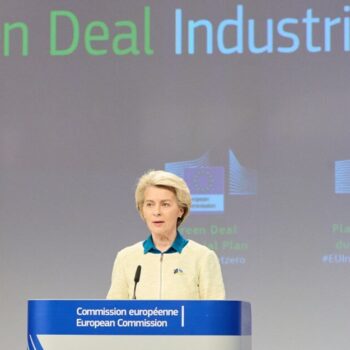In the midst of the current global recession, bold action will be needed to stimulate the economy, generate jobs and lay the foundations of a sustainable recovery. This action could provide a new impetus for a low carbon economy that is efficient, innovative and sustainable. Some governments, on the national level, are already implementing such measures in an effort to address the range of challenges simultaneously.
However, we know that limiting global emissions to levels well below a 2 degrees C rise in temperature will require a step-change in global innovation and diffusion to make a zero-carbon energy economy feasible before 2050. The question is whether Copenhagen can be the global moment when the signal is given that those companies that want to operate and prosper in a low carbon economy will have a leg up, and provide a framework for this to happen.
Summary
Copenhagen will be a defining moment in the evolution of the market for low carbon technologies
Bold, new thinking on technology cooperation and diffusion is required to accelerate the scale and pace of low carbon innovation and meet our climate, energy security and economic growth goals
Business engagement will be crucial to ensure the right frameworks are created to deliver transformational change
Underlying the emission reduction trajectories produced by the UNFCCC and IEA are aggressive assumptions on the early commercialisation of key technologies such as high penetration renewables, electric vehicles, low carbon cement and steel production, carbon capture and storage and new biofuels. While the development of cap and trade systems will help the diffusion of some technologies, it clearly will not drive all of the technologies needed at the scale and speed required. Without a credible global framework to spur action and increase business competition, we will not make the necessary investments to achieve a low carbon transformation.
Copenhagen will be crucial to provide this global framework and lay the foundations for a sustained low carbon recovery. This year will be a defining moment in determining the future shape and growth of the global market for low carbon technologies. It is crucial that Copenhagen establishes the right global architecture and acts as an engine for low carbon growth. For the first time both emissions reductions and technology are front and centre, offering an opportunity to ensure that both goals can be simultaneously achieved.
The Copenhagen Agreement must include both targets and actions to curb global emissions and goals and measures to deliver the necessary technology and innovation in order to limit global temperature increases well below 2oC. This will be the only way to provide credible incentives for private investment, avoid high carbon lock-in and deliver future jobs and growth. Global cooperation for technology will be vital to provide our future climate security. To achieve a 2oC world we must simultaneously develop and deploy new and existing technologies in developed and developing countries. However, over last 25 years public energy R&D funding by major developed countries has fallen by 50% in real terms over the last 25 years.
Fundamentally climate related innovation will reach new markets when companies are presented with the right balance of risk and reward. Action is therefore required to increase the size and certainty of markets and overcome other market failures to drive private investment. The private sector should work to ensure Copenhagen provides a strong signal on the future evolution of the carbon market, targeted support for the development and demonstration of technologies, market regulation and access issues and structures to maintain incentives for future innovation investment.
This urgent need points to several key questions for business engagement:
- How can we achieve a global goal to increase public RD&D and diffusion support on the scale required to stabilise temperature rises below 2oC? In the past discussions have focused on either taking emissions reductions targets or technology targets, but it is now clear that we need both. The European Commission has proposed quadrupling energy related RD&D from current levels by 2020. Will this be sufficient? What about other sectors?
- What institutional structure is required inside and outside of the UNFCCC? How can the UNFCCC link to existing structures? What frameworks are required to ensure outcome based technology cooperation? How can we generate international technology action programmes with private sector involvement for key strategic technologies?
- What is the best way to facilitate international joint-ventures and public-private partnerships? The Copenhagen Deal is likely to drive more collaborative R&D with emerging economies such as China and India. How can we produce more effective models for co-development and joint-ventures? How can we ensure effective private sector participation in this process?
- How can we protect incentives for climate-related innovation while enabling the benefits to be shared at the necessary speed?A “protect and share” agreement involving government-to-government commitments for IPR and licensing of climate technology could resolve this dilemma. On the one hand, multilateral funding could help developing countries to strengthen their IPR protection measures consistent with existing commitments under WIPO and the WTO. On the other hand, enhanced IPR protection would be balanced by a framework agreement for the use of existing provisions to accelerate the diffusion of technology. This should include actions such as the use of parallel markets, advance purchase commitments, compulsory licensing, pay to licence systems and the use of Global Commons. How can business and countries come together to have a productive conversation on IPR issues? What will it require to build trust in this area? How can we ensure that taxpayers receive a fair return for supporting private sector activities?


